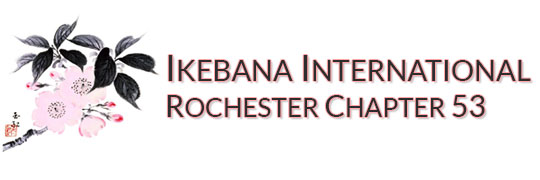
There are many different schools of ikebana. Each school started and developed in its own unique way. Subsequently, each school has its own style or visual flavor. The Ichiyo School of Ikebana tends to emphasis the use of live materials. Of course there are some materials which are used and are not living materials such as the containers or supporting structures (frames, grids, paper, etc.) that are included in the arrangement, but they are used to augment the beauty of the live materials. In this post, different arrangements will be shown that use items which are characteristic of the Ichiyo School of Ikebana.
These arrangements are shown courtesy of Ms. Valerie Eccleston. She is an Executive Master in the Ichiyo School of Ikebana who lives in the Washington, DC area. There is no higher title than “Executive Master” in the Ichiyo School of Ikebana other than being the headmaster (Iemoto).
She started her training in ikebana in the 1970’s while living in Japan. Even though she has subsequently lived in England, Canada, Connecticut, Texas, Arizona and now Virginia, she has continued her training through those years. She has also demonstrated, taught, and exhibited in the United States and Canada in places such as the Metropolitan Museum Asian Galleries in New York and participated in an Ichiyo School Exhibition in Soho. She is presently the President of the Ichiyo School of Ikebana, Washington DC Chapter.
Use of Grids
In the above arrangement, and also in the arrangement to the right, one can notice the use of a grid. Many grids which are used are square grids. But, in these arrangements, the grids have been manipulated to have an unconventional shape. As stated above, these offer more interest to the arrangement in terms of texture and color, but they are not the main

part of the arrangement and don’t detract from the beauty of the flowers or the arrangement as a whole. Interesting enough, these types of grids may be purchased at stores which sell simple cabinet furniture and supplies.

In this arrangement example to the left, we see another type of grid, though it is not the square type. It is a prominent element in this arrangement, but it compliments the curving nature of the container and calla lilies in a way that does not detract from those elements. It also offers support to the living materials used.
This vase has multiple holes in it allowing the floral material to come out at different levels and sides of the arrangement and the curving grid helps bring them all together in a circular way.
As one can see, in these few examples, grids can be used in more than one way. One is only limited on how grids can be used by their imagination.
Use of Bamboo
In the last remaining arrangement pictures, one is going to see the use of bamboo. The previous post on large (Taisaku) arrangements showed how bamboo can be used in a large scale arrangement. The example here shows a piece of bamboo which

has been colored gold and with a marking at the closest end. Bamboo can also be used in the Ichiyo School as a frame in an arrangement (Hana-tsuitate), or as multiple linked frames like a screen in an arrangement (Hana-byoubu).

In this arrangement to the left, one again sees the gold-painted bamboo used but as an extension of the vase. It would be very difficult to arrange flowers in the way shown here in a large mouth vase without a support such as the bamboo.
But, with the bamboo in place, it works out well. This arrangement also shows how beautiful a large arrangement can be with only a few elements–in this case a single red anthurium, one green leaf, and one bunch of baby’s breath.
